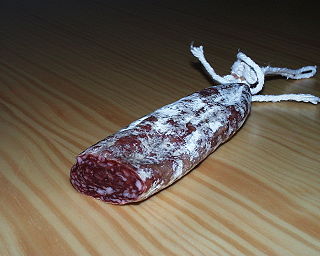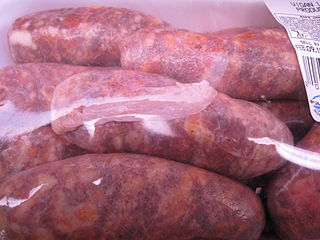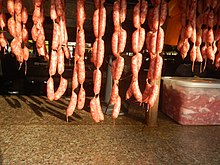
Pampanga is a province in the Central Luzon region of the Philippines. Lying on the northern shore of Manila Bay, Pampanga is bordered by Tarlac to the north, Nueva Ecija to the northeast, Bulacan to the east, the Manila Bay to the central-south, Bataan to the southwest and Zambales to the west. Its capital is the City of San Fernando. Angeles, while geographically within Pampanga, is classified as a first-class, highly urbanized city and is governed independently of the province.

Candaba, officially the Municipality of Candaba, is a 1st class municipality in the province of Pampanga, Philippines. According to the 2015 census, it has a population of 111,586 people.

Pampanga River is the second largest river on the island of Luzon in the Philippines and the country's fifth longest river. It is in the Central Luzon region and traverses the provinces of Pampanga, Bulacan, and Nueva Ecija.
The legislative districts of Pampanga are the representations of the province of Pampanga and the highly urbanized city of Angeles in the various national legislatures of the Philippines. The province and the city are currently represented in the lower house of the Congress of the Philippines through their first, second, third, and fourth congressional districts.

Longaniza is a Spanish sausage (embutido) similar to a chorizo and also closely associated with the Portuguese linguiça. Its defining characteristics are interpreted differently from region to region. It is popular in the cuisines of several regions of Spain, Argentina, Uruguay, Puerto Rico, Dominican Republic, El Salvador, Mexico and Chile. In the Philippines, it is called longganisa and differs greatly with hundreds of variants with different vernacular tastes and forms due to the 144 ethno-linguistic groups in the archipelago.
Alaminos longganisa, also known as longganisa Pangasian, is a Filipino pork sausage originating from Alaminos City, Pangasinan. It is a type of de recadolongganisa. It is made with ground lean pork, ground pork fat, brown sugar, coarse salt, saltpeter, black pepper, vinegar, and garlic in hog casings. It is typically bright yellow or orange due to the use of achuete seeds. The segments of the sausage are uniquely divided by small pieces of coconut leaf midribs. Each sausage string usually has six segments and is traditionally tied at the end with a length of buli palm fiber. The sausages are celebrated in an annual "Longganisa Festival" in Alaminos City.

Vigan longganisa, also known as the Ilocano longganisa, is a Filipino pork sausage originating from Vigan City, Ilocos Sur. It is a type of de recadolongganisa. It is made with ground lean pork, ground pork fat, brown sugar, garlic, onions, bay leaves, soy sauce, vinegar, black pepper, and salt to taste in hog casings. Chili flakes may also be added. The sausages are celebrated in an annual "Longganisa Festival" in Vigan City.
Chorizo de Bilbao, also known as Chorizo Bilbao, is a Filipino dry pork sausage. The name originates from a genericized trademark. It is native to the Philippines and does not originate from Spain, despite common misconception. The sausage was originally produced by Vicente Genato of the Genato Commercial Corporation in Manila. The name was coined by Genato from his family's original home city of Bilbao, Spain. Today, most of the production has shifted to the American company Marca El Rey, who copied the branding. The sausages are popular among Filipino American communities in the United States and the Philippines. The ingredients of Chorizo de Bilbao is mostly identical to other Filipino longganisas, except for the addition of paprika and its dry texture.
Chorizo de Macao, sometimes called Chinese Chorizo or Longaniza Macau, is a Filipino dry pork sausage. It is native to the Philippines and does not originate from Macau or China, despite the name. The ingredients of Chorizo de Macao is identical to other Filipino sweet longganisas, except for its dry texture and its use of star anise, aniseed, or anise liqueur (anisado), which gives it its distinctive aroma and its name. It is commonly used in Chinese Filipino dishes like pancit Canton and siopao. It is sometimes confused with and used in place of Chinese sausage.

Chorizo de Cebu, also known as longganisa de Cebu, is a Filipino pork sausage originating from Cebu, Philippines. It is a type of hamonada (sweet) longganisa. They are distinctively red in color due to the use of achuete seeds. Each link is also usually spherical in shape. It is made from ground lean pork, ground pork fat, salt, saltpeter, sugar, anise liqueur (anisado), paprika, black pepper, garlic, and chilis to taste in a hog casing. It can also be made without the casing. They are usually fried or grilled and eaten with white rice, puso, or garlic rice for breakfast.
Longganisa de Guinobatan is a Filipino pork sausage originating from the town of Guinobatan in Albay, Philippines. It is a type of de recadolongganisa. Each link is typically only 2 inches (5.1 cm) in length. It is made from lean pork, pork fat, salt, sugar, garlic, saltpeter, and black pepper. Unlike other Philippine sausages, the meat is uniquely chopped by hand. The dish is celebrated in the annual "Longganisa Festival" of Guinobatan.
Cabanatuan longganisa, also known as batutay, is a Filipino beef sausage originating from Cabanatuan City, Nueva Ecija. It can be served sweet (hamonado), garlicky, or "skinless". It is celebrated in the annual "Longganisa Festival" of Cabanatuan City.

Calumpit longganisa, also known as longganisang bawang, is a Filipino pork sausage originating from Calumpit, Bulacan, Philippines. It is a type of de recadolongganisa. It is made with lean pork, pork fat, garlic, bay leaves, brown sugar, soy sauce, vinegar, salt, black pepper, paprika, and optionally, chili.

Pampanga longganisa is a Filipino pork sausage originating from the province of Pampanga. It is a type of hamonado (sweet) longganisa. It is typically longer and thinner than other Philippine sausages. It is made with pork, garlic, brown sugar, black pepper, coarse salt, and vinegar. It can be prepared with or without the casing. It is typically dyed orange or red with achuete seeds. It is the most common sweet-type longganisa eaten throughout the Philippines, since it is commercially mass-produced.

Lucban longganisa is a Filipino pork sausage originating from Lucban, Quezon. It is a type of de recadolongganisa. It is characterized by its use of oregano and its garlicky and sour taste. It is made with lean pork, pork fat, coarse salt, garlic, oregano, paprika, sugar, and vinegar. It can be prepared with or without the casing.
Tuguegarao longganisa, also known as the Ybanag longganisa, is a Filipino pork sausage originating from the Ybanag people of Tuguegarao City, Cagayan. It is a type of de recadolongganisa. It is made with coarsely ground pork, black pepper, garlic, coarse salt, and cane vinegar in hog casings. It is typically dyed orange with achuete oil.
Chori burger, also known as chorizo burger, is a Filipino hamburger characteristically made with chorizo (longganisa) patties, banana ketchup, mayonnaise, and atchara, in addition to tomatoes and lettuce. It was first popularized by Merly's BBQ, a street food stall in the island of Boracay in the Philippines. A version of the burger with a half-longganisa and half-beef patty from Jeepney Restaurant was declared the best burger in New York City in Time Out's 2014 "Battle of the Burgers" competition.
Chicken longganisa is a Filipino fresh sausage made with minced chicken meat, garlic, onion, soy sauce, muscovado sugar, salt, vinegar, and black pepper. Vegetable extenders can also be added like carrots, turnips, or jicamas. It is sold as a healthier alternative to other kinds of longganisa. It is usually prepared without the casing ("skinless"), and is molded into shape with the use of wax paper.
Fish longganisa or fish chorizo, is a Filipino sausage made with fish instead of pork or beef. It is typically made from tuna, tilapia, or milkfish. It is prepared identically to other Filipino longganisa and is marketed as a healthier alternative. It may use regular pork casings, vegetable-based casings, or are prepared "skinless".
Baguio longganisa is a Filipino pork sausage originating from the city of Baguio. It is a type of hamonado (sweet) longganisa.










